Workforce Management Settings
The following section describes the various settings associated with managing your Workforce.
Manage Skills & Skill Levels
Once defined, Skills and Skill Levels can be assigned to Technicians and Task Types and used by the Tech Recommendation / Auto Scheduler to match a Technician with a Task Type.
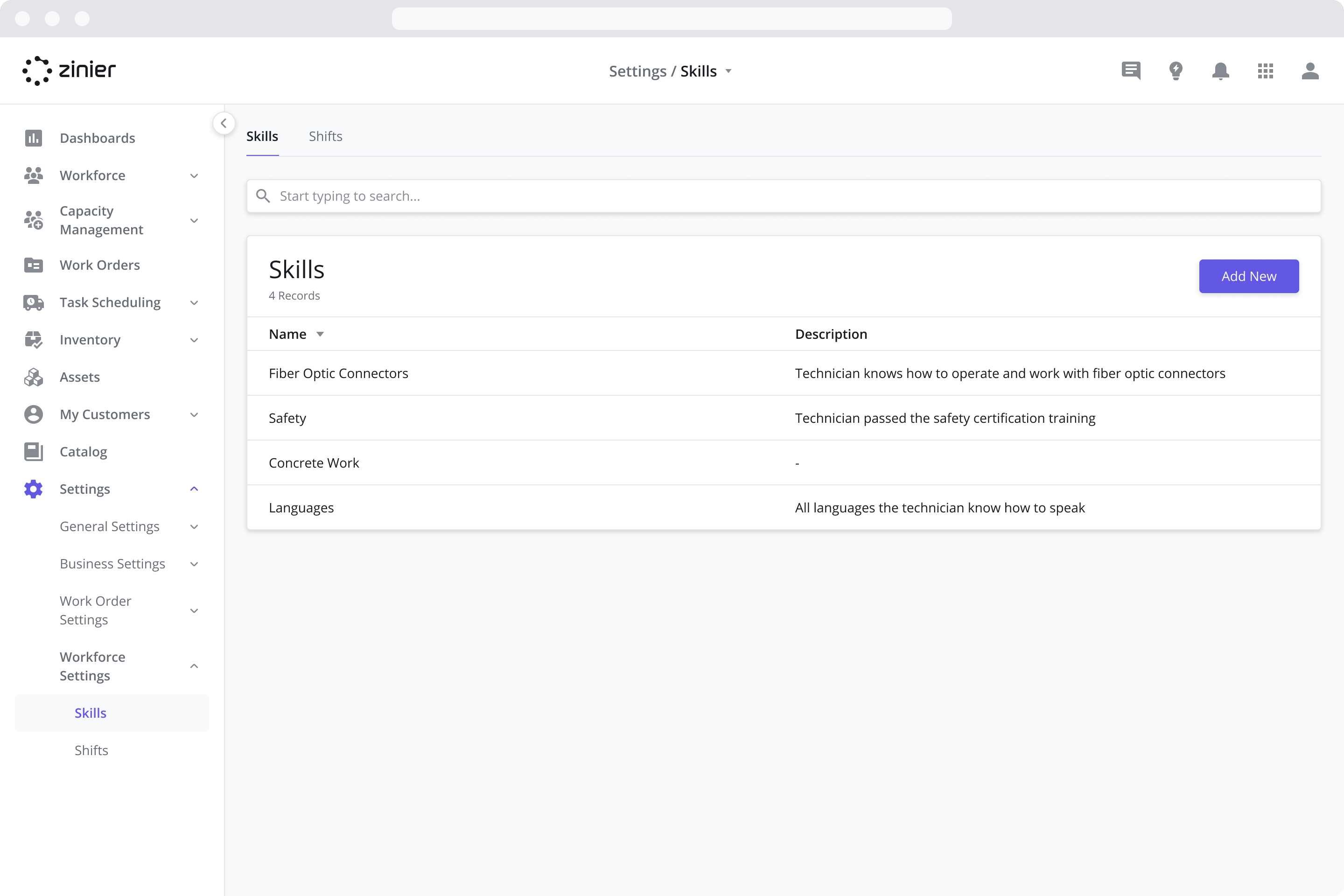
Adding New Skills
To add a new Skill, follow the steps below:
Go to the Settings > Workforce Settings > Skills module
Click the “Add New” button from the data grid
Enter a Name and Description (Optional)
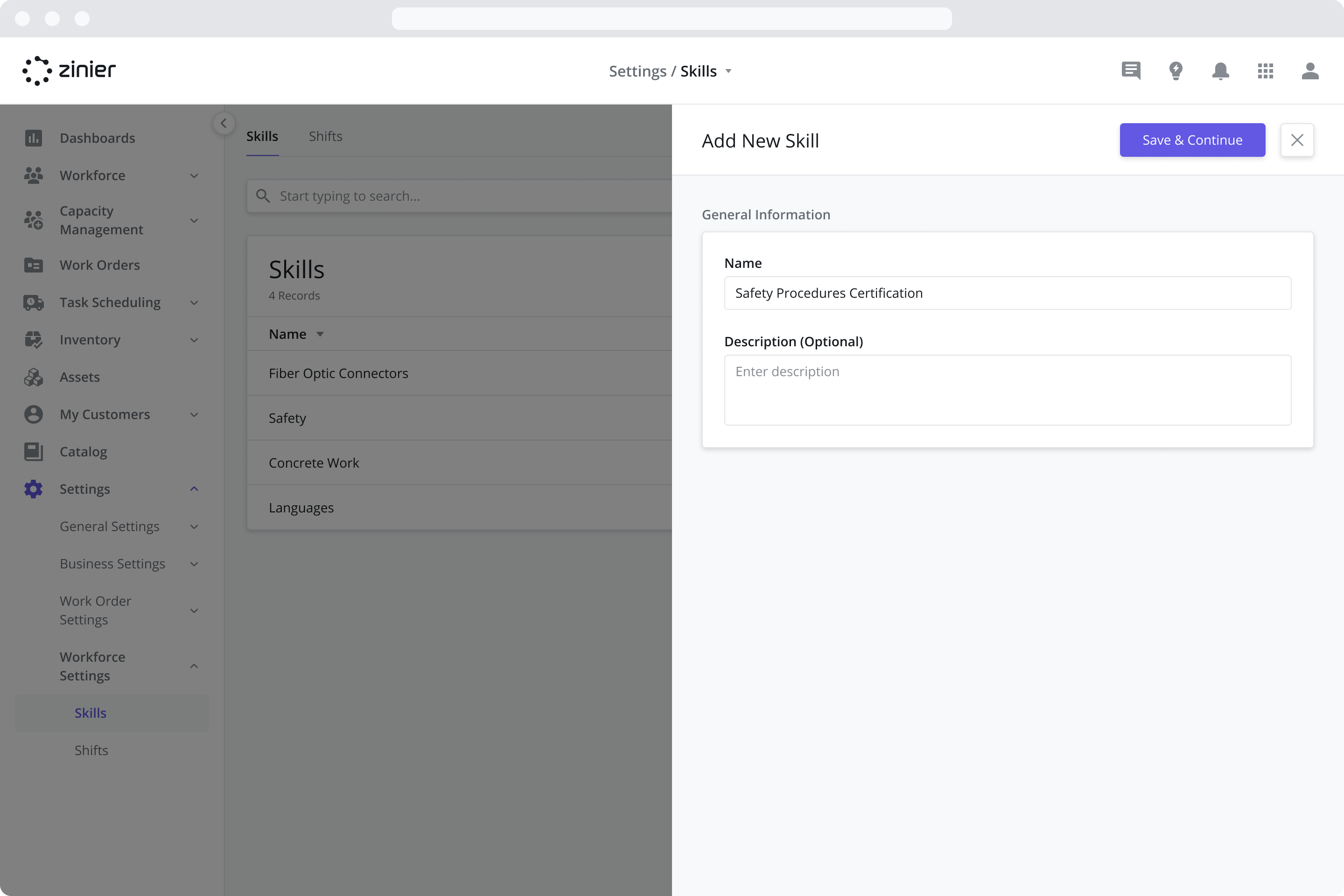
Click Save and Continue
Next, add at least one Skill Level by clicking the “Add New” button from the Skill Levels data grid
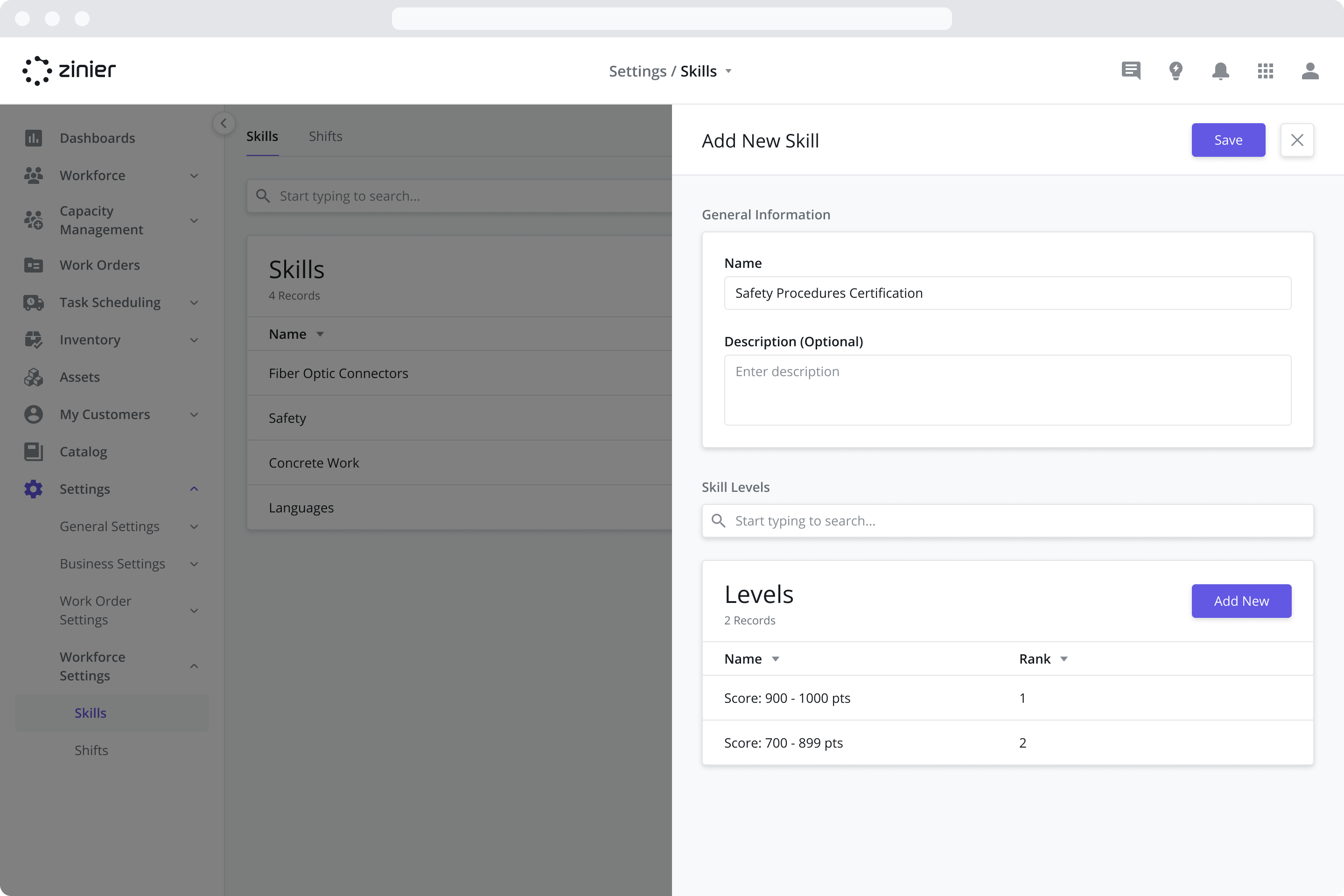
Give the Skill Level a Name and assign it a numerical Rank (0 is the lowest rank)
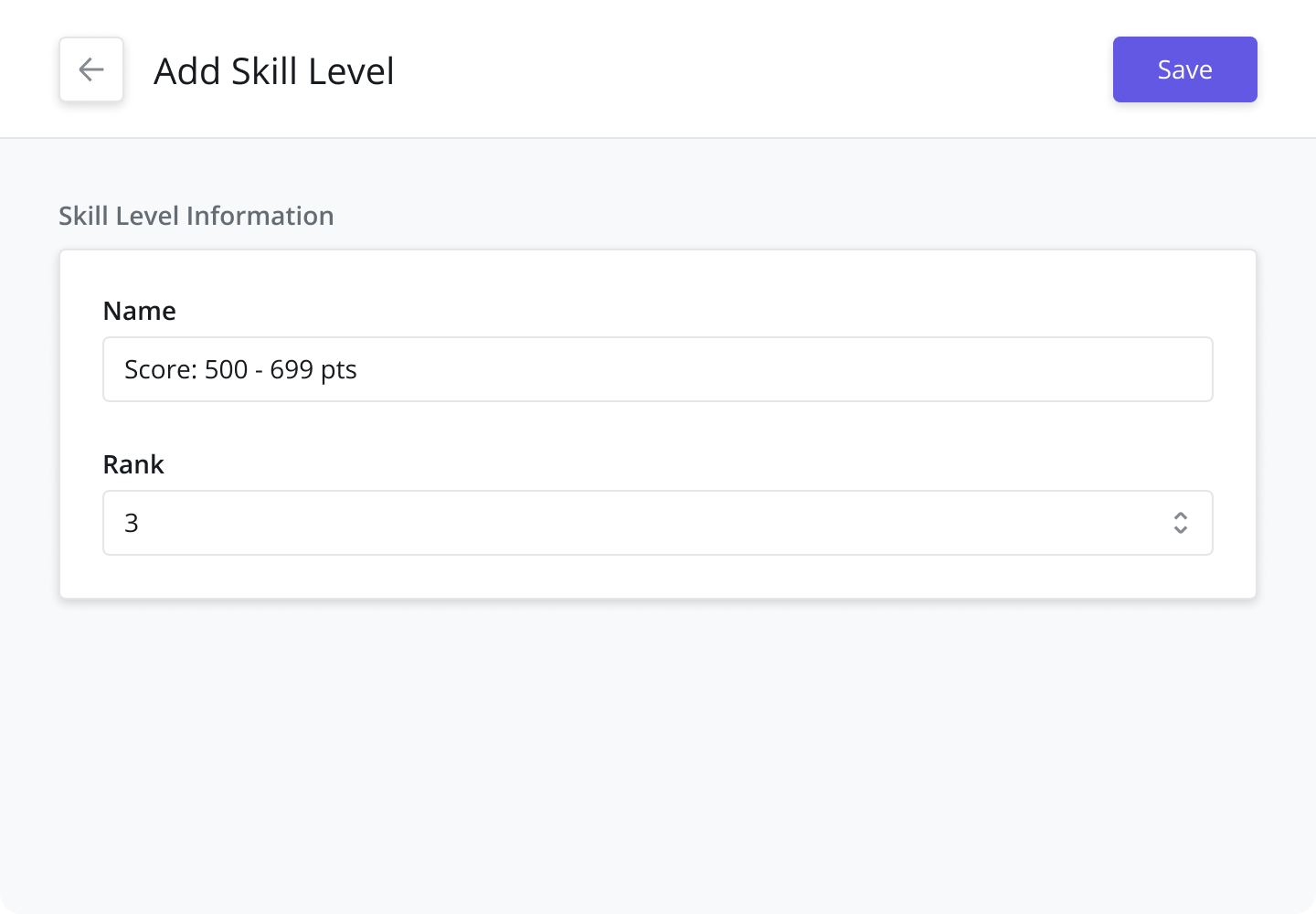
Click Save
Repeat steps 5-7 to add as many Skill Levels as needed
Manage Shift Configurations for Techs
Define (add and edit) a master list of Shift Configurations. Shifts define the weekly schedule and public holidays for a technician and are used to determine the availability of a tech when scheduling and dispatching. Once defined, Shifts can be assigned to Technicians.

Adding New Shifts
Once added, the Shift can be assigned to a Tech. To add a new Shift, follow the steps below:
Step 1: Create a Shift
Go to the Settings > Workforce Settings > Shifts module
Click the “Add New” button from the data grid
Enter a Name and Description (Optional)
Click Save and Continue
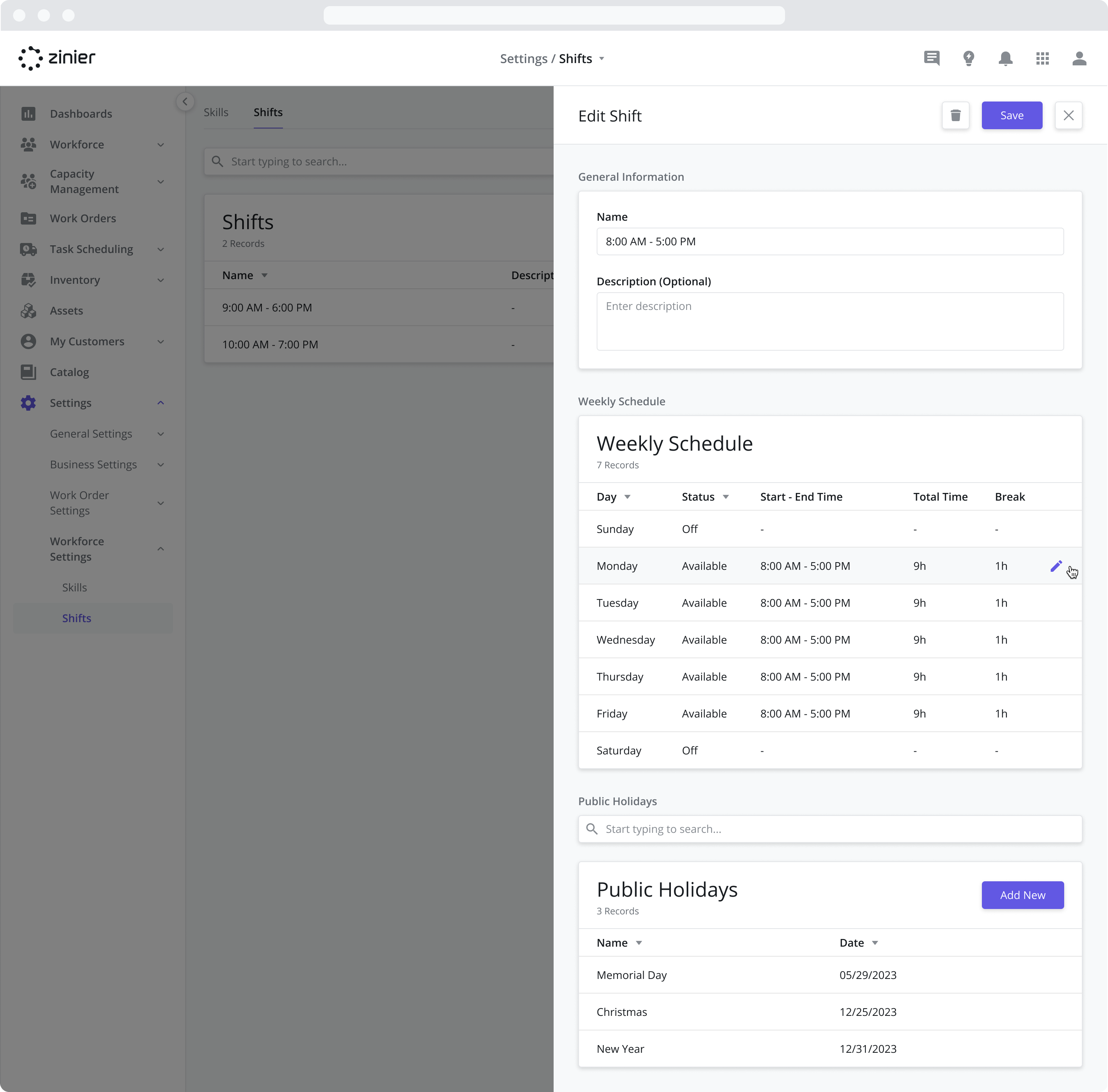
Step 2: Adjust the Weekly Schedule
Next, adjust the Weekly Schedule with the desired working hours by clicking on each day of the week from the data grid

From the Hours dropdown menu, select from the following Options:
Custom Hours: Allows you to enter a custom start and end time for the day
24 hours: Users will be available for the entire day
Off: Users will not be available to work on this day
From the Schedule dropdown, select from the following options:
Single Shift: A standard Shift with a Start Time and End Time for the day
Split Shift: This allows you to split the day into two separate segments, each with a Start and End Time.
If you’ve Selected Custom Hours and Single Shift, enter a Start Time and End Time for the day
If you’ve Selected Custom Hours and Split Shift, enter a Start Time and End Time for both Shift segments
If you’d like to Add a Break (Optional) to the day, do the following
Turn the “Add Break” toggle to On
Enter a Start Time and End Time for the Break
Provide a Minimum Break Duration
Click Save
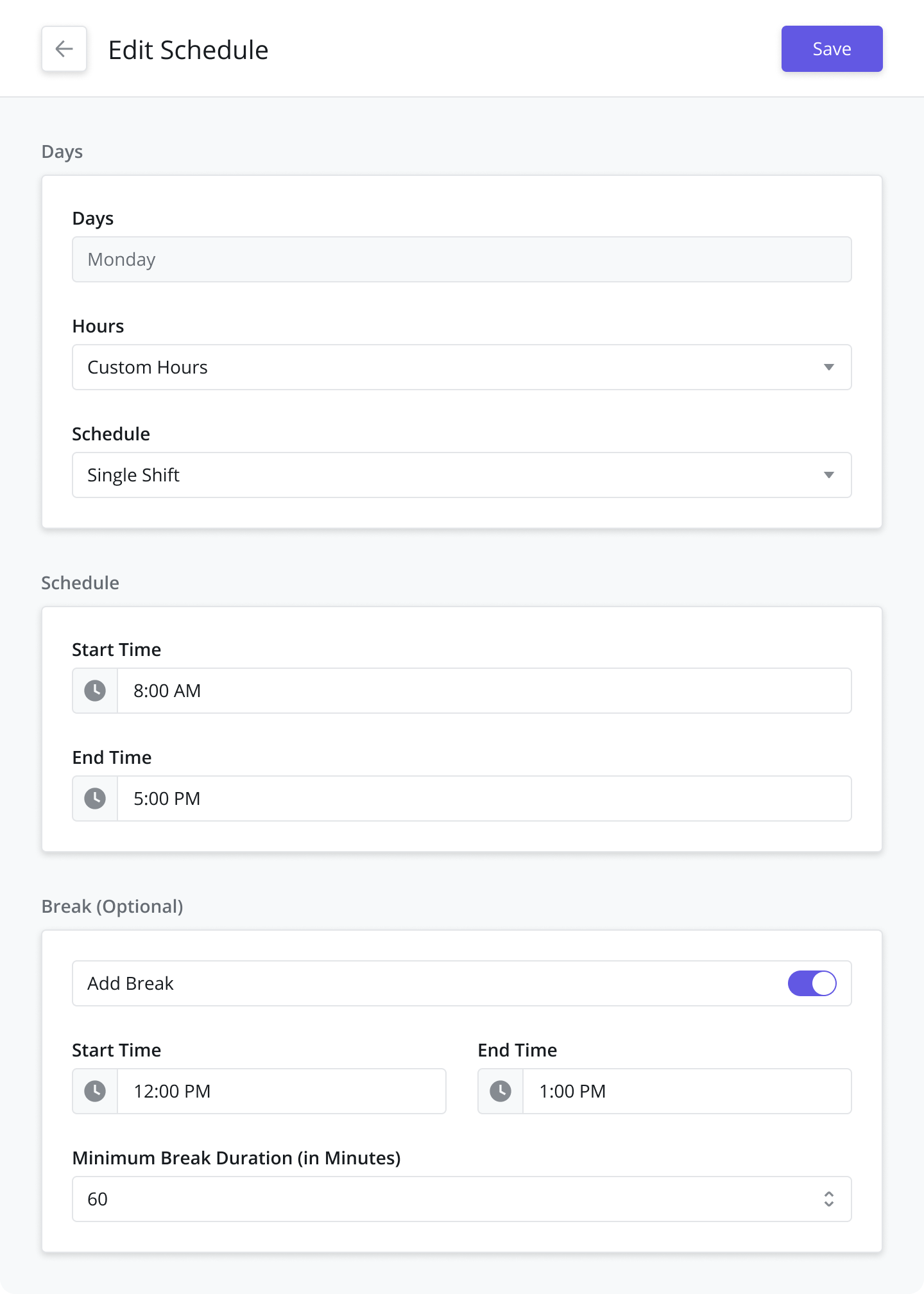
Step 3: Add your Public Holidays
Add any Public Holidays to the Shift by clicking the Add New button from the Public Holidays data grid
Click Save
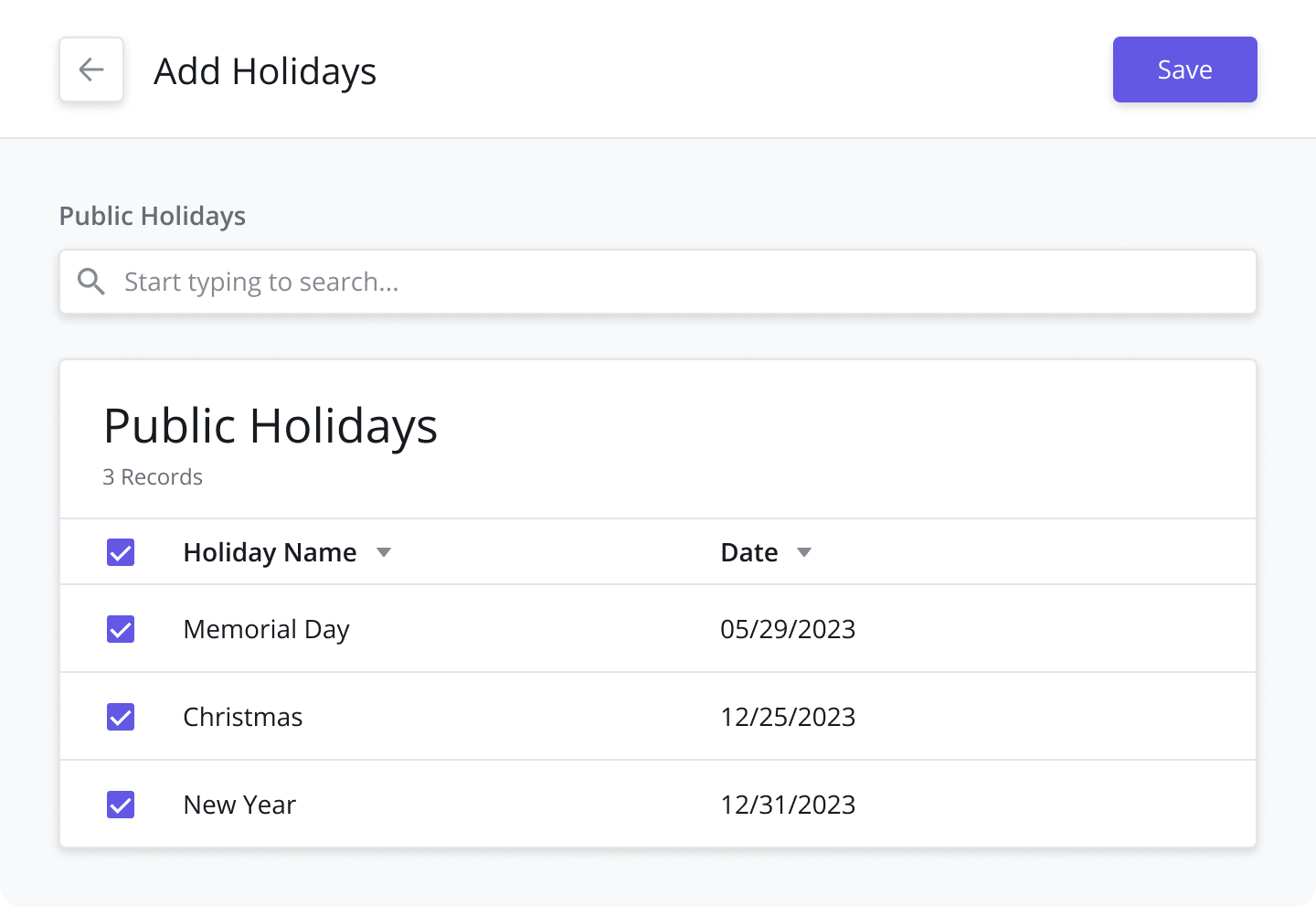
Managing Public Holidays
The Public Holidays module allows you to define a master list of Public Holidays for your Org. Once added, a Public Holiday can be applied to both Shifts and Service Windows.
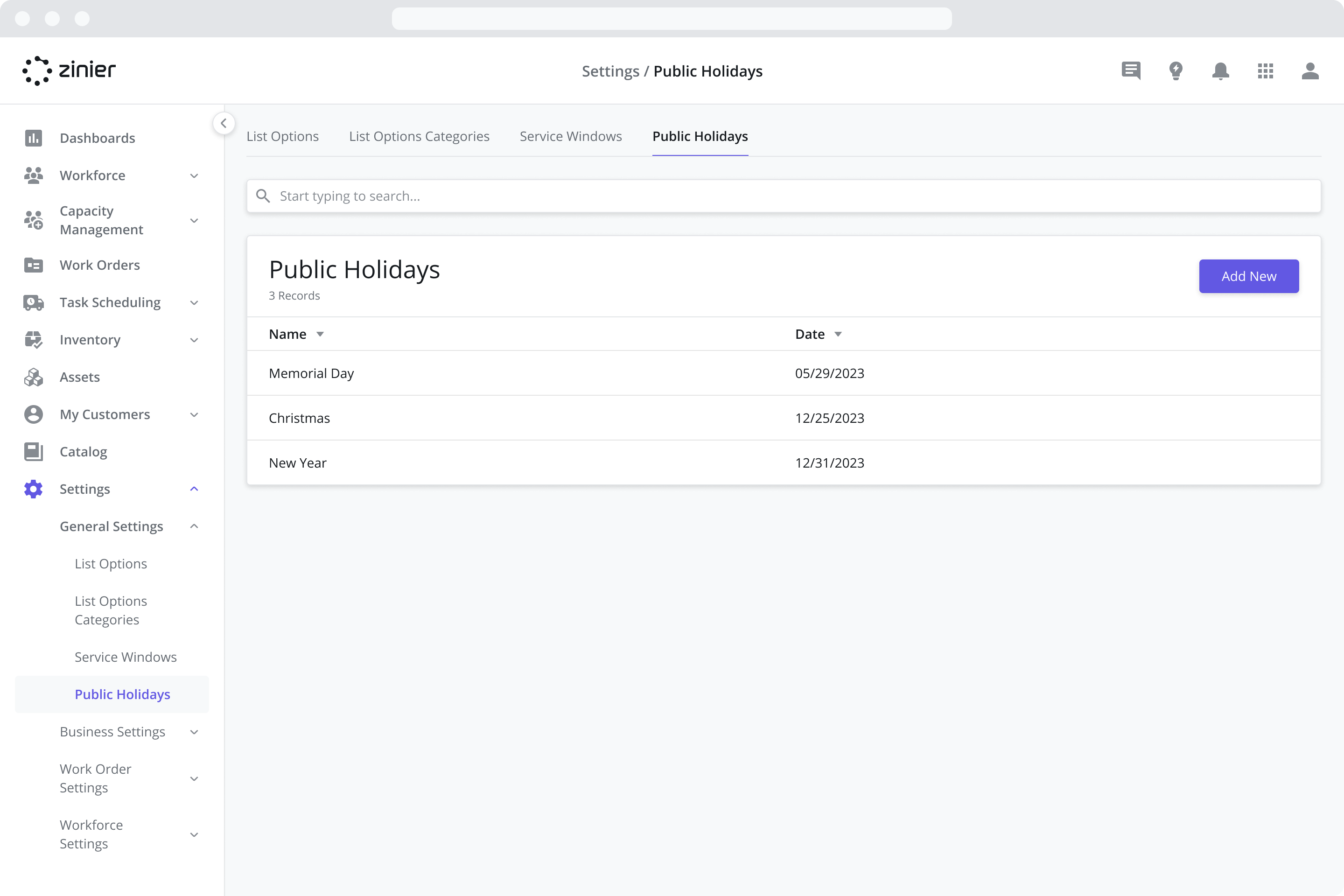
Adding a Public Holiday
To add a new Public Holiday, follow the steps below:
Go to the Settings > General Settings > Public Holidays module
Click the “Add New” button from the data grid
Enter the “Holiday Name” and select a “Date” from the sidepanel
Click Save
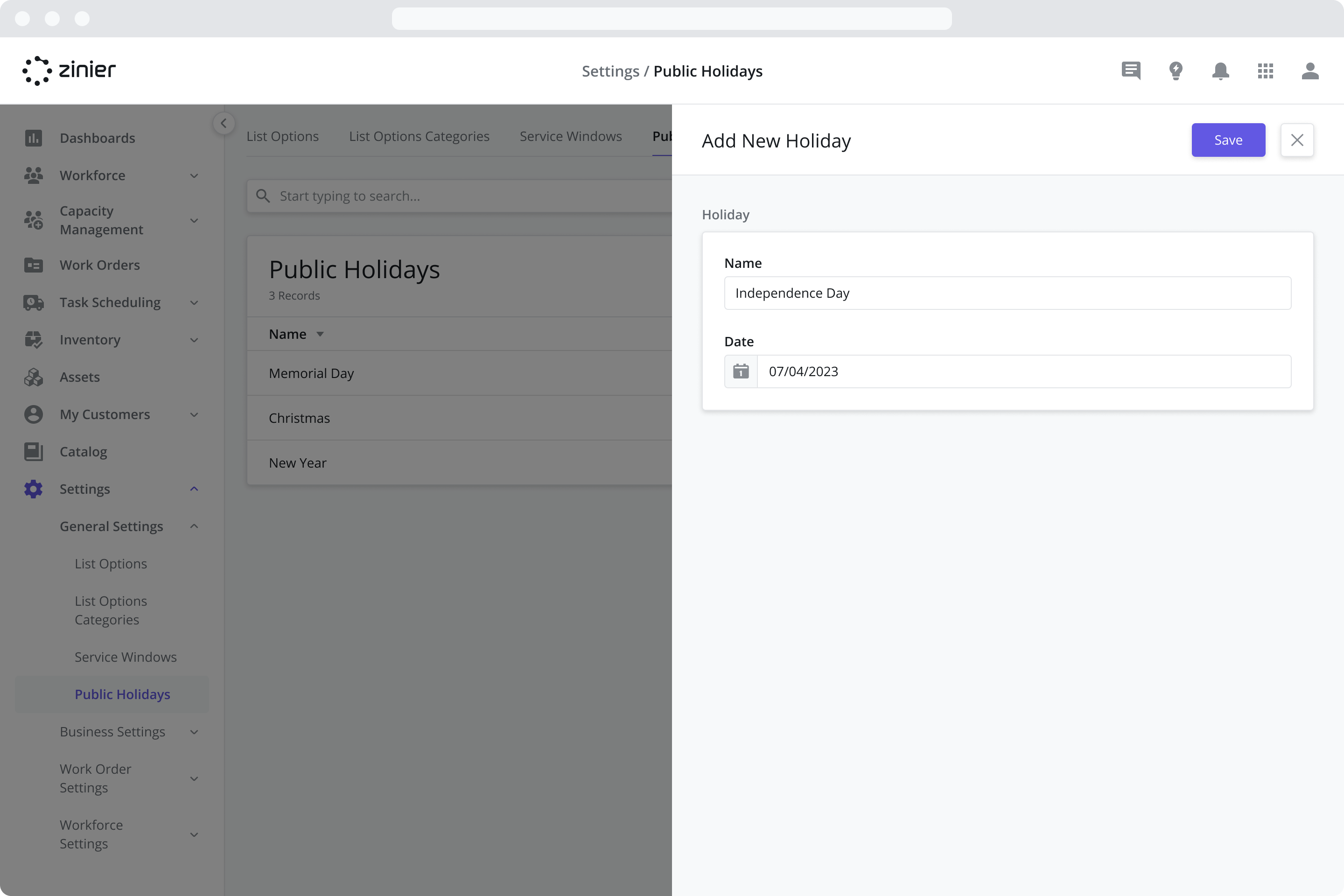
Technician Calendars / Shifts
Adding a Public Holiday to a Shift blocks off the Technician's calendar and restricts tasks from being auto-scheduled on the given holidays.
For more information on adding Public Holidays to Shifts, refer to the Shifts section.
Adding Public Holidays to Service Windows
Adding a Public Holiday to a Service Windows will restrict tasks from being performed at the Customer Site on the given holidays.
For more information on adding Public Holidays to Service Windows, refer to the Service Windows section.
Managing Regions / Sub-regions
UPDATED (24.4)
The Regions module is where you define a master list of Regions / Sub-regions for use in various related modules of the Zinier Productivity Suite. Once added, a Region can be assigned to a Contractor, Customer Site or used as a filtering criterion in Work Groups.

Adding Regions and Sub-regions
To add a Region / Sub-region to your Org, follow the steps below:
Go to the Settings > Business Settings > Regions module
Click the “Add New” button from the data grid
Give the Region a Name and Description (Optional)
Enter the Average Travel Time (mins) for the Region. This is used when calculating Capacity for tasks performed in that Region. For more information on how travel time impacts capacity, visit the Capacity Points View page.
Select a Timezone for the Region. The Timezone you select here can be leveraged in the Solution for various purposes.
Click Save and Continue
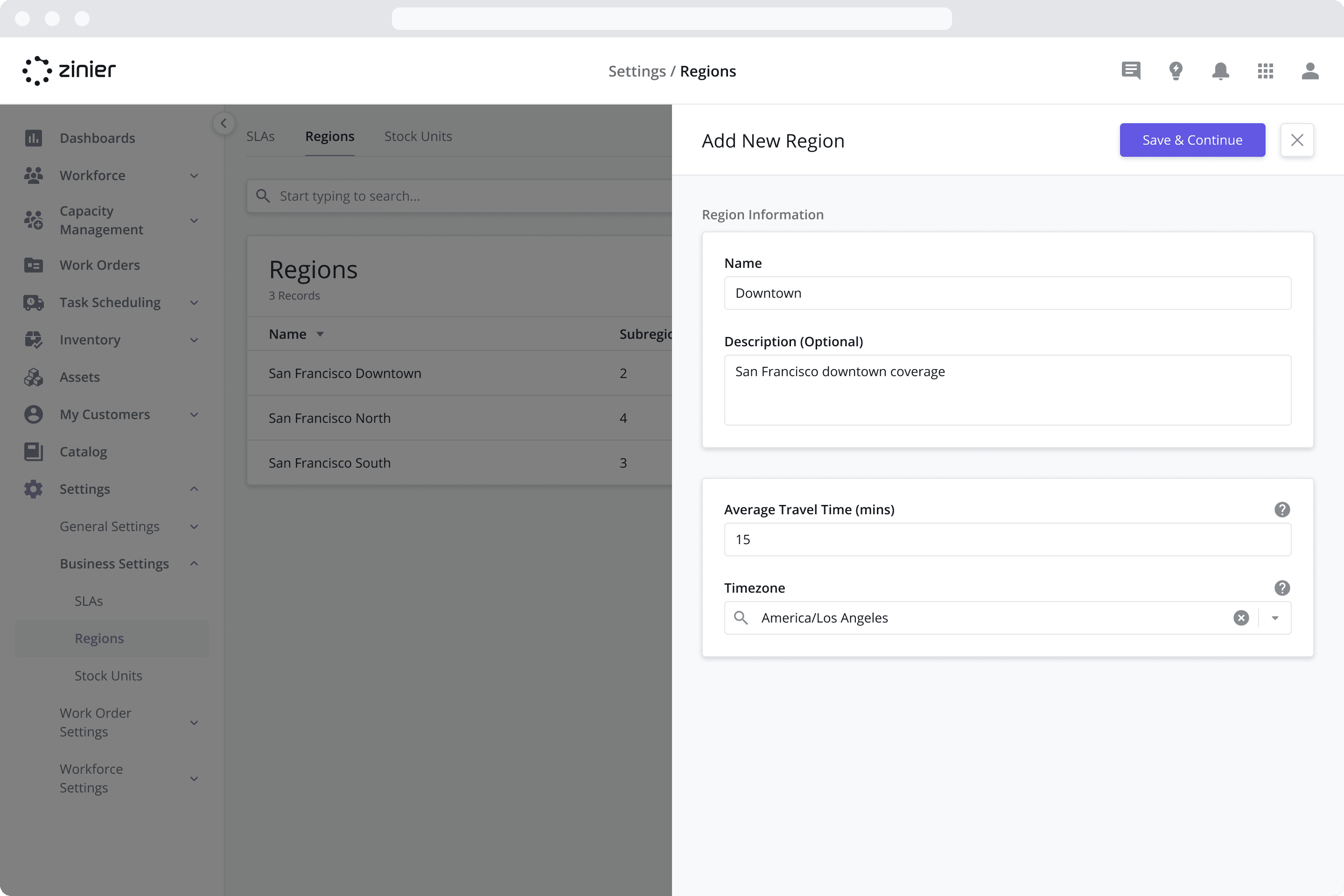
To add a Sub-region, click the “Add New” button from the Subregion data grid.
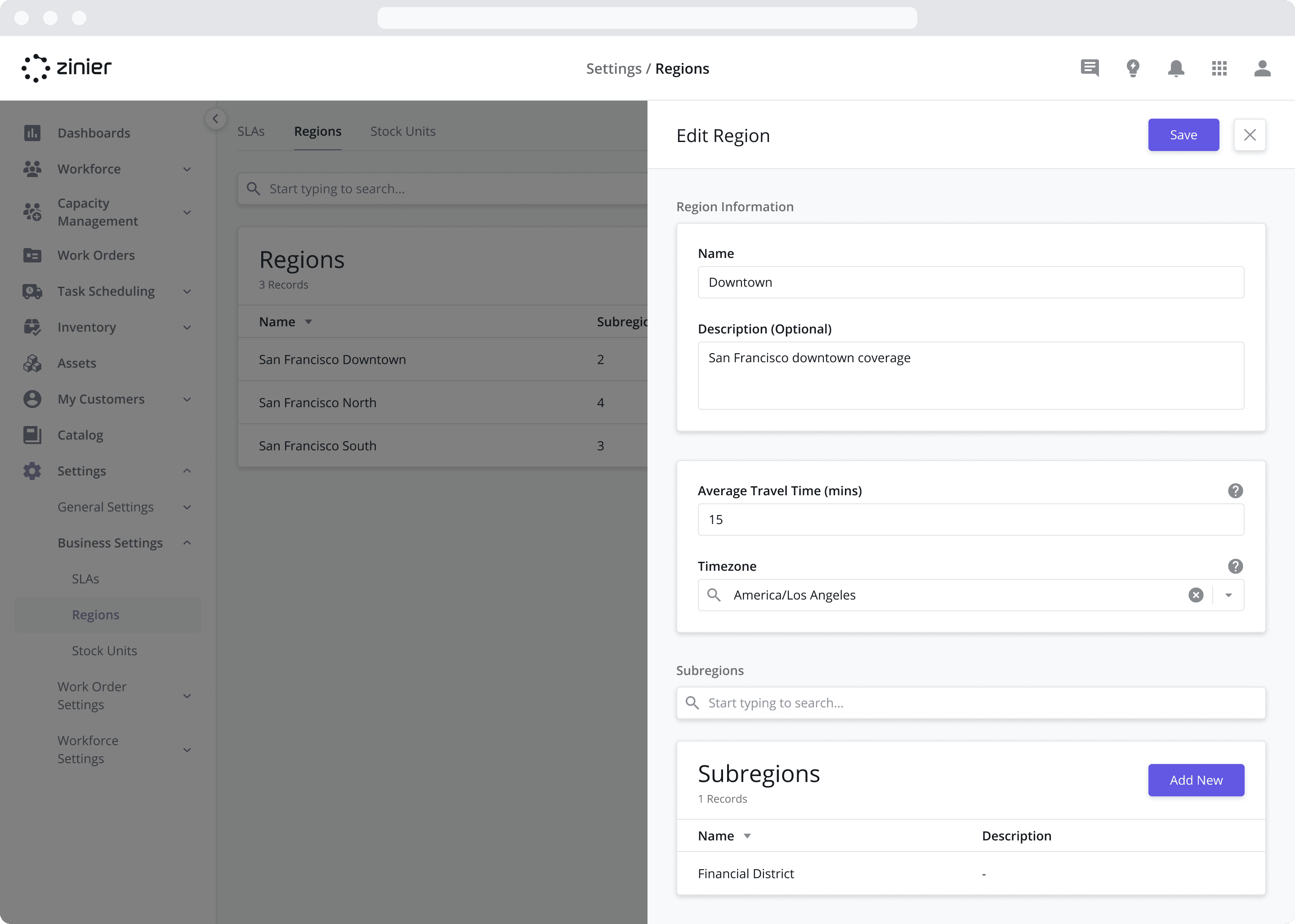
Give the Subregion a Name and Description (Optional)

Click Save
Add as many Subregions as needed
Using Regions with Contractors / Customer Sites
Regions are (optionally) used as part of the matching criteria when assigning a Technician to a Task at a Customer Site. IF a technician has been assigned to a Contractor, when the Tech Recommendation attempts to match a Technician with a Task, it will check to see if the Region of the Customer Site matches the Region(s) of the Contractor(s) the Technician is associated with. If the Technician is associated with a Contractor with the same Region as the Customer Site, the Technician can be assigned to Tasks performed at the Customer Site.
For more information on adding Regions to a Customer Site, refer to the Customer Sites page.
Using Regions with Work Groups
Regions are primarily used as a filtering criterion in Work Groups to help filter tasks and technicians so Web Users only see the tasks and technicians that they are responsible for.
For more information on adding Regions to a Work Group, refer to the Work Groups page.
Using Regions with Capacity
Regions are also used as a primary filter when viewing capacity. Planners and workforce managers can filter by Region (and Task Type) to gain a real-time view of their team’s capacity for a particular Task Type and Region when using the Points View. This helps them understand the used and forecasted capacity on a specific day for a Region / Task Type combination, enabling better workforce planning.
For more information on how Regions can be leveraged to understand capacity, refer to the Capacity Points View page.
